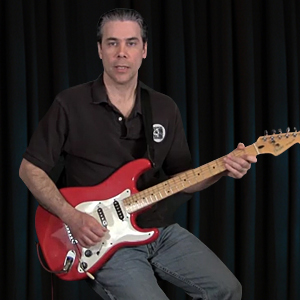Description
Now we know some open position chords. We also know what a scale is and how to play some single note melodies using scales. At this point we need to learn how scales and chords are related to each other. The first thing we need to understand is that chords are built from scales; a chord is a specific group of notes from a scale played together, at the same time.
A chord is built by playing the 1st scale degree-note (root), the 3rd degree-note and 5th scale degree-note of any given scale together. This forms what is also known as a triad. I informally call this the Leapfrog Principle because we start on a note (C) and "leap over" the next note (D) to use the following note in building the chord (E). Leap again over the (F) and use the (G). Hence, the chord is built from the C major scale is the notes C-E-G; the C major chord. This is the basic principle known as Triadic Harmony.
The distance (the interval) between the notes of the chord gives us the formula for all major chords: 1st note of chord, 4 half steps (or 2 whole steps), 3rd note of chord, 3 half steps (or 1 and a half steps), 5th note of chord.
A chord can be played in many different configurations on the fretboard. Any place you can find on the guitar to play the three scale notes that comprise a chord is acceptable.
The open chords positions are typically regarded as the easiest and most basic patterns to use in order to play those chords. In this case since we started with a C major scale, I am showing that the C amjor chord shape is a way of isolating only the 1st, 3rd, and 5th scale degrees from the C major scale. The open chord shape of the C major chord is one particular way of isolating only
the 1st, 3rd, and 5th scale degrees of the C major scale. So only those notes ring out and therefore it results in a C major chord sounding.
Lesson Info
Tutorial Lessons
- Scale And Chord Relationships: Lesson 1
- Scale And Chord Relationships: Lesson 2
- Scale And Chord Relationships: Lesson 3
- Scale And Chord Relationships: Lesson 4
- Scale And Chord Relationships: Lesson 5
- Scale And Chord Relationships: Lesson 6
- Scale And Chord Relationships: Lesson 7
- Scale And Chord Relationships: Lesson 8
- Scale And Chord Relationships: Lesson 9
